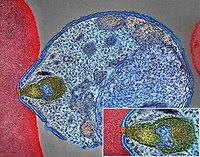
Photo from wikipedia
Globally, diseases transmitted by arthropod vectors, such as mosquitoes, remain a major cause of morbidity and mortality [1]. The defense responses of mosquito and other arthropod vectors against parasites are… Click to show full abstract
Globally, diseases transmitted by arthropod vectors, such as mosquitoes, remain a major cause of morbidity and mortality [1]. The defense responses of mosquito and other arthropod vectors against parasites are important for understanding disease transmission dynamics and for the development of novel disease-control strategies. Consequently, the mechanisms by which mosquitoes resist parasitic infection (e.g., immune-mediated killing) have long been studied [2, 3]. However, the ability of mosquitoes to ameliorate the negative fitness consequences of infection through tolerance mechanisms (e.g., tissue repair) has been virtually ignored (but see [4, 5]). Ignoring parasite tolerance is especially taxing in vector biology because unlike resistance, which typically reduces vectorial capacity, tolerance is expected to increase vectorial capacity by reducing parasite-mediated mortality without killing parasites [6], contributing to the recurrent emergence of vector-borne diseases and its stabilization and exacerbation. Despite its importance, there is currently no evidence for the evolution of tolerance in natural mosquito populations. Here, we use a common-garden experimental framework to measure variation in resistance and tolerance to dog heartworm (Dirofilaria immitis) between eight natural Aedes albopictus mosquito populations representing areas of low and high transmission intensity. We find significant inter-population variation in tolerance and elevated tolerance where transmission intensity is high. Additionally, as expected, we find that increased tolerance is associated with higher vectorial capacity. Consequently, our results indicate that high transmission intensity can lead to the evolution of more competent disease vectors, which can feed back to impact disease risk.
Journal Title: Current Biology
Year Published: 2019
Link to full text (if available)
Share on Social Media: Sign Up to like & get
recommendations!